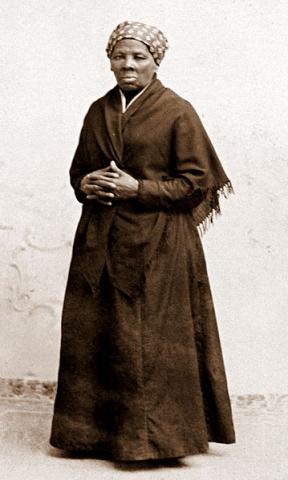Harriet Tubman, c 1885. The photo, by H. Seymour Squyer, is unusual in that the left side of Ms. Tubman's face is not hidden by a shadow and reveals the injury she suffered when she was young. The original is maintained by the National Portrait Gallery. Image online, courtesy Wikimedia Commons.
Harriet Tubman, a runaway slave from Maryland who became known as the "Moses" of her people, helped slaves attain freedom in Canada and the northern states. As a young woman, she had experienced the cruelty and inhumanity of slavery firsthand when she refused to help an overseer whip another young slave who had gone to the store without permission.
When the offending slave tried to run away from his punishment, the overseer threw a heavy iron weight at him. It hit Tubman (known then by her birth name “Araminta Ross”), nearly crushing her skull, leaving a deep scar, and causing seizures which she endured for the rest of her life.
Knowing the risk of helping runaways was high, Tubman - it is said - would not allow people to change their minds once she agreed to help. If slaves tried to turn back, she reportedly pointed a gun at them and said:
You’ll be free or die a slave.
Although there were rewards for her capture, she followed her conscience as she did what she could to help slaves escape from states like Maryland and Delaware. It is said she once observed:
On my Underground Railroad I [never] run my train off [the] track [and] I never [lost] a passenger.
With the assistance of her friends, William and Frances Seward, she bought a home in Auburn, New York. (At the time, Seward was Senator of New York; later, as Lincoln’s Secretary of State, he was stabbed on the night Lincoln was assassinated).
Harriet lived a long life and, when she died in 1913, was buried with military honors at Ft. Hill Cemetery.
History records others who helped slaves make their way on the Underground Railroad:
- William Still, a free-born African American who has been called “Father of the Underground Railroad,” recorded many first-person accounts of people who escaped from the south. His entire book - more than 800 pages - is available for on-line reading.
- William Jackson and his family, pictured here in 1846, were abolitionists who lived in Newton, Massachusetts. Their home was a station on the underground. Today that house is a museum.
- John Fairfield, son of a slave-holding family, reportedly undertook many daring rescues and devised inventive ways to keep escaping slaves safe.
- Levi Coffin, who reportedly helped many slaves, wrote Reminiscences about his efforts and those of his wife, Catharine Coffin. Some scholars believe his claims of assistance were greatly exaggerated.
Many others assisted slaves who wished to break free from the bondage of American slavery. Much of their work was done in secret; consequently, myths and legends layer actual stories about the Underground Railroad.
Through it all, however, one fact remains unmistakably clear: The yearning to be free is a human response so powerful that people will often risk everything to attain it.


 Back
Back
 Next Chapter
Next Chapter

 Back
Back

